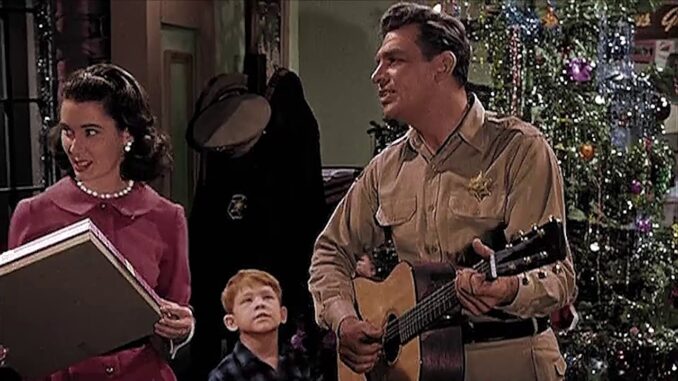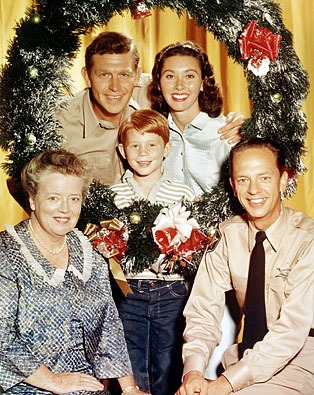
Introduction: A Mayberry Christmas You Thought You Knew
You’ve probably watched the “Christmas Story” episode of The Andy Griffith Show a dozen times, maybe more. It’s warm, cozy, and filled with that classic Mayberry charm. But even the most loyal fans might have missed some fascinating and surprising little details nestled within the holiday cheer.
In this deep dive, we’re going to unwrap nine subtle but significant elements that you likely never caught. So grab a mug of hot cocoa and settle in—Mayberry’s holiday spirit has more layers than Aunt Bee’s fruitcake.
The Only Christmas Episode in the Entire Series
While the show ran for eight seasons, “Christmas Story” is the only dedicated Christmas episode in the entire series. Surprised? It aired on December 19, 1960, during Season 1. The writers chose never to revisit the holiday theme again—making this episode a one-of-a-kind gift to fans.
It Wasn’t in the Original Airing Order
Even though “Christmas Story” is the 11th episode in production order, it was originally aired as Episode 11 due to scheduling the holiday episode near Christmas. Production shuffled the air dates to make the yuletide theme land right before December 25. A bit of strategic programming, don’t you think?
The Prisoners Weren’t Real Felons
Here’s a detail that often goes unnoticed: The prisoners in the jail were staged to make Sam Muggins’ family feel welcome. Andy didn’t just throw them in with hardened criminals; he cleverly used locals and had them act as inmates. It’s a quiet touch, showcasing Andy’s trademark heart-over-law approach.
Andy’s Guitar Scene Was Totally Improvised
When Andy picks up the guitar and sings “Away in a Manger,” you might assume it was scripted. But here’s the secret—that performance was largely improvised. Griffith was known for bringing his musical background into scenes organically. The production allowed this musical moment to unfold naturally, enhancing the warmth of the episode.
Aunt Bee’s Dress Is a Recycled Costume
If Aunt Bee’s festive outfit looks familiar, it’s because you’ve probably seen it before. Frances Bavier wore the same dress in another episode, though it was altered slightly with a different collar. Back in the ‘60s, wardrobe budgets were tight, so repurposing costumes was common practice.
The Script’s Theme Was Based on an Actual Andy Griffith Idea
Unlike many episodes, “Christmas Story” was inspired by Andy Griffith himself, who wanted an episode that reflected “a simpler, more meaningful kind of Christmas.” He pushed for a story that avoided flashy presents or commercialism. Instead, we got heartfelt community values, storytelling, and compassion.

Opie’s Reaction Was 100% Genuine
Ron Howard, only 6 years old at the time, wasn’t always told exactly what was going to happen in scenes. When Andy welcomes the Muggins family into the jail for Christmas, Opie’s surprised smile was genuine. The director often relied on Howard’s authentic reactions to keep scenes emotionally honest.
The Jail Cell Decorations Came From the Real Set Crew
Those tinsel-covered bars and decorations weren’t from a props department. The production crew—not the art department—pitched in to make the jail feel festive. They used whatever decorations they had available and even brought some from home. Talk about DIY holiday cheer!
The Director Slipped In a Nod to Charles Dickens
“Christmas Story” contains a subtle homage to “A Christmas Carol” by Charles Dickens. Think about it: a grumpy figure (Ben Weaver) is shown the error of his ways, has a change of heart, and embraces the spirit of giving. Sound familiar? The director, Bob Sweeney, was a Dickens fan and laced the episode with similar redemption themes.
Lighting Was Softened Intentionally for Emotional Impact
Unlike the usually bright sitcom lighting, “Christmas Story” features warmer and dimmer lighting, especially during the musical and jail scenes. The intention? To evoke the mood of candlelight and intimacy—capturing the essence of an old-fashioned Christmas evening.
The “Jailhouse” Was Symbolic, Not Just Literal
This episode flips the concept of the jail on its head. Instead of being a place of punishment, the Mayberry jail becomes a symbol of community and warmth. Andy essentially turns it into a home filled with laughter and kindness—challenging viewers’ expectations of justice and generosity.
Ben Weaver’s Role Was Meant to Be Temporary
Ben Weaver, the Scrooge-like figure in the episode, wasn’t initially expected to be a returning character. But actor Will Wright nailed the role so well that writers brought him back in a few more episodes. His character’s transformation in “Christmas Story” became a blueprint for his later appearances.
No Laugh Track in the Final Scene
One rare production detail: the final jailhouse scene contains no laugh track. This was intentional. Producers wanted the emotional climax—Andy playing the guitar, the Muggins family gathered around—to land softly and sincerely without audience noise. It’s subtle, but it makes a big difference.
It Was Almost Cut for Being “Too Sentimental”
Believe it or not, CBS executives were hesitant about airing the episode. They worried it was too sentimental and lacked comedic punch. Andy Griffith himself reportedly pushed to keep it in the lineup, believing audiences needed more heart than humor during the holidays. He was right.
Background Music Was Composed Just for This Episode
The gentle background score you hear as Andy sings and the family gathers around wasn’t reused from previous episodes. It was originally composed to match the mood of the “Christmas Story.” Subtle and touching, it helped elevate the emotional arc without drawing attention to itself.
Conclusion: A Holiday Masterpiece in Mayberry
“The Andy Griffith Show: Christmas Story” is more than a nostalgic television episode—it’s a heartfelt mini-movie packed with warmth, humanity, and messages that still resonate decades later. Behind the simple story lies a tapestry of tiny, thoughtful details that give it lasting magic. Whether it’s Andy’s improvised performance, Opie’s genuine reaction, or subtle Dickensian nods, each element is a brushstroke on a Norman Rockwell-like canvas of Americana.
So next time you rewatch this holiday classic, look a little closer—you might just see Mayberry in a whole new light.
FAQs
1. Was “Christmas Story” the only Christmas episode of The Andy Griffith Show?
Yes, it was the only dedicated holiday-themed episode throughout the show’s eight-season run.
2. Who played the character Ben Weaver, and did he return in future episodes?
Will Wright portrayed Ben Weaver. He appeared in a few more episodes after this one, largely due to the popularity of his role in “Christmas Story.”
3. Was Andy Griffith really playing the guitar in that scene?
Absolutely. Andy Griffith was an accomplished musician, and the performance was genuine and mostly unscripted.
4. Why was there no laugh track in the final scene of the episode?
Producers chose to omit the laugh track to allow for a more sincere, emotionally resonant ending. It’s a deliberate decision that heightens the holiday sentiment.
5. What’s the deeper meaning of the jailhouse in the episode?
In “Christmas Story,” the jailhouse symbolizes community, forgiveness, and unconventional holiday warmth—turning a place of punishment into a home full of heart.
